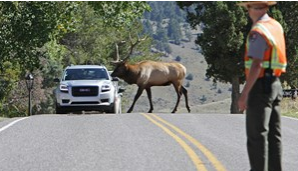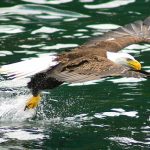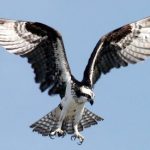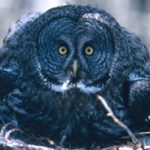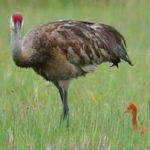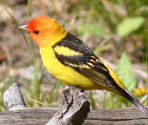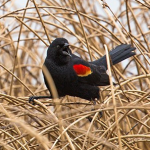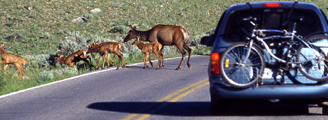
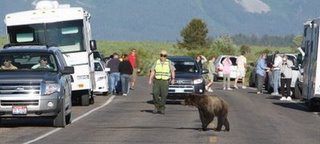
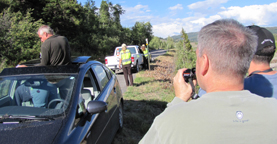
Yellowstone National Park has this advice for people “viewing or photographing roadside animals, whether you are alone or in a wildlife jam:

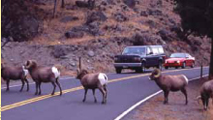
Park in established turnouts and make sure your car is completely off the paved roadway.
Make sure you put your vehicle into park and engage the parking brake.
If you exit your vehicle, stay near your vehicle so you can get inside if a bear or other wildife approaches.
Avoid being struck by a moving vehicle – do not stand in the roadway to view or photograph wildife.
Never surround, crowd, approach or follow wildlife.
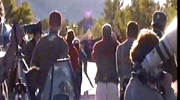
Don’t block an animal’s line of travel.
Do not run or make sudden movements – this may cause predators to attack.
If other people in the area are putting you in danger, leave the scene and/or notify a park ranger.
Do not ever feed wildlife, including birds.”
Watch a bear jam video at: https://www.nps.gov/yell/learn/photosmultimedia/minute_bearjams.htm

Below: putting your flashers on does not give you permission to partially block the roadway at a bison crossing (were they trying for a photo?). Note that this rental motorhome had plenty of space to pull over if the driver had thought to. Note also the traffic congestion he caused when people tried to drive around him.
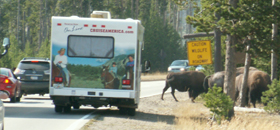
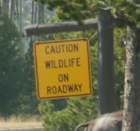
Below: a moose jam near the entrance to Jackson Lake Lodge in Grand Teton national park. The roadway at this location has plenty of space for cars to pull well off the road. Where there is not enough space, if you choose to park not quite off the roadway and your side mirror is clipped off by a passing motorist, the damage is in part your fault.
![]()
Please park at the side of the road only on pavement. Parking on natural vegetation causes permanent damage to plants.


____________________________
Grand Teton National Park offered this about bear / wildlife jams:
“Managing the Human Side of the Jam
Unmanaged wildlife jams can quickly become chaotic. While it may come as a surprise, the greatest danger is often not the animal, but the traffic. Drivers who stop must comply with the following safety protocols:
Do not approach the animal
Do not park in front of a crossing animal
Follow directions from park staff
Recognize these are dynamic situations and instructions may change suddenly
Expect a lot of people and be aware of your surroundings ; expect visitors on foot to suddenly cross the travel lane; be prepared for young children to unexpectedly run across the road
Do not block the lane of travel
Never park in the road
Park to right of the white line, ensuring all four tires are out of the travel lane
If you step outside your vehicle, be alert for traffic; do not stand in the road
Depending on the animal’s behavior, nearby curves, or visibility conditions, it may be unsafe to exit a vehicle at all. In these cases, the Wildlife Brigade and other park staff will assess the situation and provide guidance. Staff may ask visitors to remain in their vehicle or slowly drive through the area.
There may be times when bear jams need to be shut down due to unsafe conditions or unreasonable disturbance to the animal. When this occurs, you can help by departing the scene and looking for wildlife in other areas of the park.”
![]()
Grand Teton Park ran these photos with a clarification of animal jams rules reprinted below:

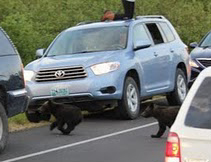
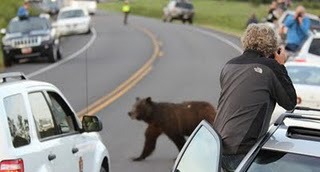
July 27, 2011
Grand Teton National Park Superintendent Mary Gibson Scott today authorized a clarification of the 2011 Superintendent’s Compendium to more clearly describe regulations for safe wildlife viewing and allowable distances between visitors and wildlife. The clarification was prompted by the increased size and complexity of “wildlife jams” associated with the presence of grizzly bears near park roadways.
A long-standing provision of the compendium required that visitors keep a specified distance from wildlife. This historic provision was based upon determinations by previous superintendents that such limitations were necessary for the protection of wildlife and the safety of visitors. The allowable distance between visitors and wildlife has been defined as 100 yards from bears and wolves, and 25 yards from other animals, including nesting birds. The current compendium maintains those distances, but provides improved clarity to the rule by eliminating language that was ambiguous or unclear. The compendium now states,
“The following activities are prohibited:
a) Willfully approaching, remaining, viewing, or engaging in any activity within 100 yards of bears or wolves, or within 25 yards of any other wildlife including nesting birds; or within any distance that disturbs, displaces or otherwise interferes with the free unimpeded movement of wildlife, or creates or contributes to a potentially hazardous condition or situation.
b) Failure to remove one’s self to prescribed distances during inadvertent, accidental, casual or surprise encounters with wildlife.
c) Failure to comply as directed by NPS staff (employees, volunteers, or agents) engaged in administering wildlife management operations or managing wildlife viewing opportunities.”
The appearance this year of grizzly bears #399 and #610 and their collective five cubs creates unprecedented opportunities for park visitors to view superb wildlife; these opportunities also increase appreciation for animals and national park values. At the same time, the tremendous interest in viewing these bears and other wildlife has resulted in large wildlife jams and caused situations where the well being of both visitors and animals may be in jeopardy. Wildlife viewing opportunitiesand wildlife jams in particularcan be very fluid situations due to the unpredictable behavior and movement of animals, the ebb and flow of traffic, and other factors. After a bear charged two different vehicles on two separate occasions while people stood on their car roof, park managers recognized the need to more strictly enforce the established regulations for wildlife viewing to better secure the protection of animals and ensure visitor safety.
While Grand Teton provides remarkable opportunities for visitors to experience and enjoy wildlife and other resources, park managers must also establish conditions that allow sufficient and appropriate space in which individual animals can move unencumbered as they search for food and other critical needs.
____________________________
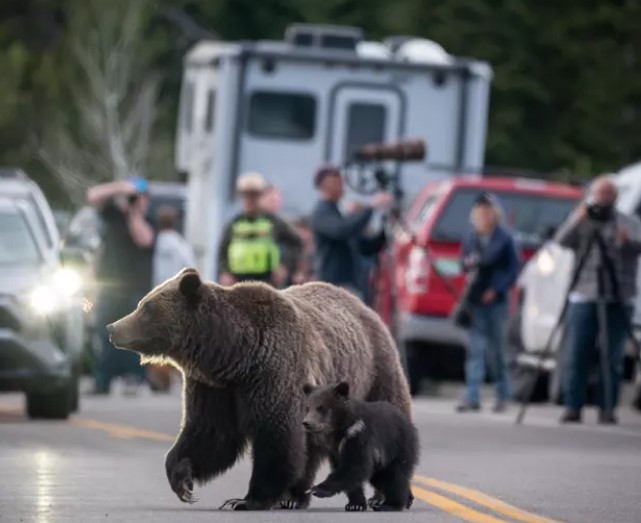
Again, park rules say, for your safety and theirs, do not approach wildlife, stay 100 yards from bears or wolves and 25 yards from other wildlife including nesting birds, whether in your vehicle or on foot.
Keep the animal’s line of travel or escape route clear and move away if wildlife approaches you.
How far away is 100 yards? Picture the length of a football field without the end zones.
25 yards? picture four car lengths or six kayak lengths, or the width of an Olympic-sized pool like ours at the college.
If you have an accidental, surprise or inadvertent closer encounter with wildlife you must remove yourself to those distances, including while driving on a road.
Safe Distances from Wildlife includes reasons to stay away from even friendly seeming animals in parks, and charts and photos to better be able to determine and visualize how far away from wildlife you need to stay to be safe (and obey laws that do have penalties).
Grand Canyon National Park rangers say: “Follow the rule of thumb: if you can cover the entire wild animal with your thumb you’re at a safe distance. This distance is usually 25 yards from most wildlife and 100 yards from large wildlife . . . If you are close enough to take a selfie with an animal, you are too close. ”
Parks Canada warns, along with keeping a proper distance from animals :
“If you spot the following defensive warning signals, pull back even more or leave the area:
Bears make a ‘woofing’ noise, growl and snap their jaws;
Bull elk and moose put their heads down and paw at the ground;
Cow elk flatten their ears, stare directly at you and raise their rump hair.
If you cause an animal to move, you are too close.”
This NPS photo came with this warning:
“when a moose is stressed it will lay its ears back along its head and its hackles will rise.”
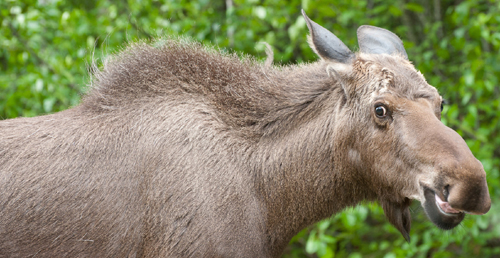
• Denali National park warns: “Moose are not predatory, and they will not try to eat you. Instead, they try to trample a perceived threat.”
____________________________
You will really want your own binoculars.
and a telephoto lens for your camera.
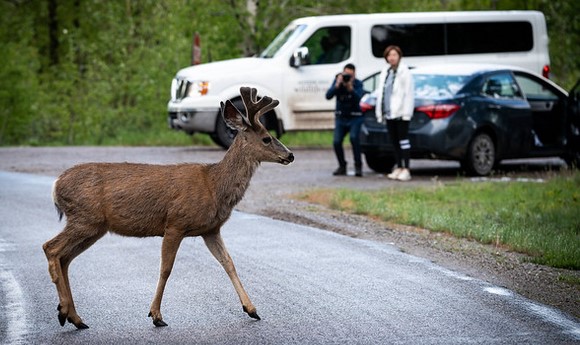
____________________________
In this photo of a bison about to cross a road, note the size of the bison (10-12 feet long, 5-6 feet tall at the shoulder) in comparison to the people and their cars. If the bison decided to change his direction of travel, or move quickly, people could have been injured.
Read about what may happen before a bison charges
and see your safety in grizzly bear territory
__________________________________
HOW MANY BEAR JAMS?
In 2013 Grand Teton park recorded “a minimum of 548 wildlife jams including at least 153 grizzly bear jams, 174 black bear jams, 42 jams for bears of unknown species, 117 moose jams, and 42 jams for other species such as bison elk and coyotes.”
In 2017, “recorded 670 wildlife jams including 171 for grizzly bears, 210 for black bears, 65 for bears of unrecorded species, 162 for moose, and 62 for other species such as bison, elk, and great gray owl.”
The Washington Post reported in 2024, “By the end of August, the park had tallied 651 wildlife jams, two-thirds involving grizzly or black bears; moose fueled a distant third.”
https://www.washingtonpost.com/nation/2024/09/21/grizzlies-grand-teton-national-park-wyoming/
From a 2024 Grand Teton Park report:
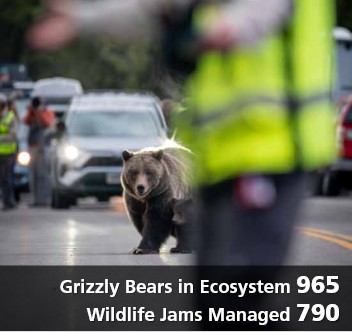
____________________________
 Was that a black bear or a grizzly, a coyote or a wolf or a fox we just saw?
Was that a black bear or a grizzly, a coyote or a wolf or a fox we just saw?
 Rocky Mountain mammal size comparisons has photos and comparisons of beavers, squirrels, pika, marmot, elk, moose, bison, fox, coyote, wolf, golden-mantled ground squirrel, chipmunk, Red Squirrel (also known as) Chickaree, Unita Ground squirrels, bobcat, lynx, mountain lion (cougar), pine marten, mountain goats, bighorn sheep, pronghorn, grizzly and black bears, tundra swan, trumpeter swan, adult and juvenile Bald Eagles.
Rocky Mountain mammal size comparisons has photos and comparisons of beavers, squirrels, pika, marmot, elk, moose, bison, fox, coyote, wolf, golden-mantled ground squirrel, chipmunk, Red Squirrel (also known as) Chickaree, Unita Ground squirrels, bobcat, lynx, mountain lion (cougar), pine marten, mountain goats, bighorn sheep, pronghorn, grizzly and black bears, tundra swan, trumpeter swan, adult and juvenile Bald Eagles.
___________________________________
Grand Teton National Park birds has photos and details about the most common ones we can hope to see
including Bald Eagle, Red-winged Blackbird, Canada Geese, Clark’s Nutcracker, Golden Eagle, Great Blue Heron. Great Gray Owl, Harlequin duck, Loon, Magpie, Merganser, Northern Flicker (woodpecker), Osprey, Ouzel, Pelican, Peregrine Falcon, Ptarmigan, Raven, Sandhill Cranes, Steller’s Jays, Trumpeter Swan , Western Meadowlark, and Western Tanager, with links to calls / songs from most of them to listen to.
and you can Download photos of over a hundred birds of Grand Teton National Park
https://www.audubon.org/climate/national-parks/grand-teton-national-park
___________________________________
People have been seriously injured when tourists hop out of their cars without thinking about putting the vehicle in park and setting the hand brake, for example:
from the NPS Morning Report
July 30, 2015
Acadia National Park (ME) Visitor Seriously Injured When Car Rolls Over Her
On the morning of July 27th, a 38-year-old visitor sustained potentially life-threatening injuries in an accident that occurred on the Park Loop Road near the Champlain North Ridge Trailhead.
Witnesses said that members of a family got out of their vehicle at a scenic pull-off along the road and that shortly thereafter the vehicle rolled backwards towards other vehicles, park visitors, and oncoming traffic. While family members attempted to stop it by pushing against the vehicle’s exterior, the driver attempted to reenter to apply the brakes.
The vehicle, however, gained momentum due to the steep slope and they were unable to stop it. In the process of attempting to enter the moving vehicle, the driver was knocked to the ground by the open car door and was subsequently overrun by the front wheel. The vehicle crossed the road and came to rest in the ditch and against the base of a cliff. The driver was transported by Bar Harbor Ambulance to a waiting Life Flight helicopter, where she was transported to Eastern Maine Medical Center in Bangor, Maine.
Investigating rangers determined that the car’s shifter was not in the ‘park’ position. The driver sustained multiple chest injuries but is in stable condition.
____________________________
__________________________________
from the NPS daily report April 12, 2006
Badlands National Park (SD)
Pedestrian Hit By Car, Life Saved
On April 12th, rangers were notified of a vehicle/pedestrian accident at the Yellow Mounds Overlook. Responding personnel determined that a pedestrian had been run over by a motor vehicle and was trapped beneath the vehicle. She was freed and basic life support was begun. A life flight was requested because she kept drifting in and out of consciousness. Air transport was expedited through the use of prearranged landing sites coordinated between the park and life flight. The woman was airlifted and taken to the Rapid City Regional Hospital, where she was treated for head, neck, spine and leg injuries.
Investigators determined that she had stepped out of her vehicle to take several photographs when she noticed that the vehicle was starting to roll. In an attempt to stop the moving vehicle, she reached through the open door to grab the gear shift lever, but was caught by the door and pulled beneath the vehicle. It then came to rest after striking a raised curb, trapping her underneath.
____________________________
from the NPS daily report September, 2005
Rocky Mountain National Park (CO)
Fatal Accident on Old River Road
A motor vehicle accident on the afternoon of September 12th claimed the life of John Whatmough, a 32-year-old visitor from Nashua, New Hampshire. The accident occurred on Old Fall River Road approximately one half mile above Chasm Falls.
The preliminary report indicates that Whatmough and his wife got out of the vehicle to take photographs. Their two-and-a-half year old son was in the backseat of the vehicle, restrained in a child safety seat.
The Hyundai began to roll backwards and Whatmough attempted to stop the car by opening the driver’s side door and getting in. The car traveled backwards for 25 feet down a steep, rocky embankment, dragging Whatmough along, before it came to rest. Whatmough sustained multiple traumatic injuries and died at the scene. The child was uninjured. [Submitted by Kyle Patterson, Public Affairs Officer]
____________________________
from the NPS daily report Tuesday, June 17, 2003
Yellowstone National Park (ID,MT,WY)
Three Injured in Accident at Bear Jam
Three park visitors were injured on the evening of June 10th when a vehicle struck them as they were watching two black bears grazing in a meadow near Calcite Springs, approximately one mile from Tower Junction in the northeast section of the park.
Just prior to the accident, a ranger directing traffic at the location noted that a number of visitors had parked their vehicles off to one side of the road, then crossed to the other side to better view the bears. The ranger was in the process of clearing traffic when he glanced behind him and saw an unoccupied white Chrysler PT Cruiser roll away from its parked position, cross both lanes of traffic, plow into the crowd, and continue down a ten-foot embankment.
One victim, a seven-year-old girl, was knocked down, run over, and partially trapped under the vehicle; two other victims – the seven-year-old’s sister (eleven years old) and an older male (age unknown) – were struck and knocked out of the way by the vehicle. Most of the spectators did not see the vehicle coming.
By the time the ranger reached the accident scene, bystanders had moved the seven-year-old out from under the vehicle. The ranger immediately called for assistance. Rangers and staff from throughout the northern portion of the park responded and provided emergency medical care. The two girls were transported by helicopter to Eastern Idaho Regional Medical Center in Idaho Falls for additional care; the man was transported by ambulance to Livingston Memorial Hospital in Livingston. The seven-year old is listed in stable condition; she has two fractured ribs and some difficulty in breathing. Her sister was treated for an injury to her left arm and released. The man received some cuts and lacerations and was also treated and released. Park staff also provided emergency medical care for anxiety to two witnesses at the scene – one of them the owner of the vehicle, the other a woman visitor. Both were treated at the scene and released.
[Submitted by Public Affairs]
____________________________________________________


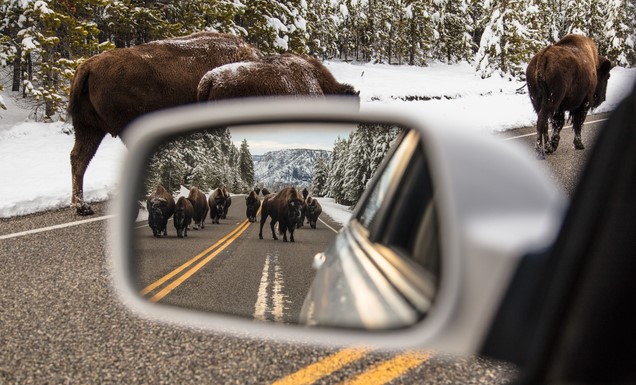
__________________________________________________________________
From the NPS Morning Report, Thursday, Jan. 29, 2009
Grand Teton National Park
Conviction And Sentencing In Assault On Visitor
On December 11th, Michael Smith, a Wyoming resident, was sentenced in federal court following a guilty plea to a charge of felony assault resulting in serious bodily injury and sentenced to 18 months in jail, three years of supervised probation, and nearly $10,000 in restitution. The conviction stems from an assault that occurred in the park on July 20, 2007. On that date, rangers received and responded to a report of an altercation on the Moose-Wilson Road near the park’s south boundary. The Moose-Wilson Road, a winding, scenic secondary road, requires slow speeds due to narrow lanes and a gravel surface and because it is a known wildlife viewing corridor. Travel along the road can be slow and challenging at different times of the year because of fall foliage and/or ‘wildlife jams.’ The altercation occurred due to an instance of road rage in which Smith assaulted the driver of a slower-moving vehicle whose occupants were looking for wildlife and had stopped because of a ‘moose jam.’ Smith punched the driver to the ground and kicked him in the head while he was unconscious, then fled. Rangers employed information provided by witnesses and surveillance evidence to develop information that eventually led to photographic lineups which were sent to various witnesses throughout the country. These in turn led to Smith’s identification. Although initially denying any involvement and refusing to cooperate with the investigating ranger and assistant U.S. attorney, Smith was eventually indicted by a federal grand jury in March of 2008. Smith was arrested on a federal warrant in the town of Jackson without incident. The successful investigation and prosecution was due to the combined efforts of the involved park rangers, led by Gros Ventre subdistrict ranger Kevin Albright, and the great assistance and efforts of assistant U.S. attorney Jason Conder. [Submitted by Karen Frauson, South District Ranger]
______________________________________
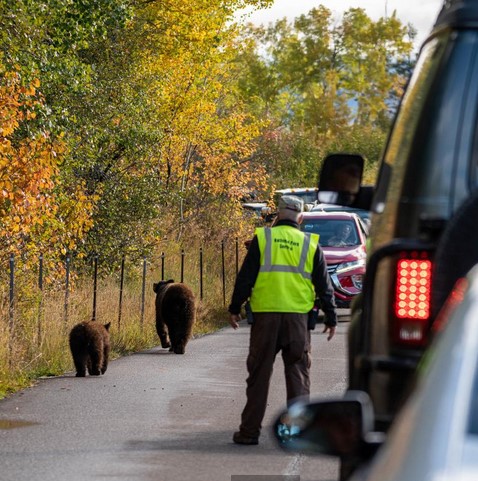
The number of bear jams increases as a larger bear population equals more bears near roads and trails. The chart below, courtesy of NPS, compares the number of visitors in millions to the number of bear jams each year in Yellowstone:
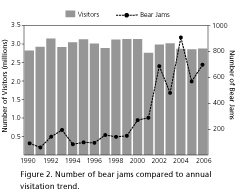
______________________________________
Road trip advice and etiquette
has practical advice from experienced and newbie carpoolers on cross country trips, including
ways to keep from being so bored;
planning before the trip;
safety issues;
drowsy driving;
packing;
road trip games, storytelling, debates and discussions;
links to gas price watch sites,
and how to deal with windows that are fogging up faster than your navigator can wipe it off.
You might also want to read How to not collide with a deer , Safe driving in rain and fog, and/or Snow chain rentals.
Prepare for winter driving has a link to bad weather driving tips, tips for using tire chains, tricks for dealing with frozen car locks, how to prepare your vehicle for winter driving, a winter survival kit for your car and what to do if you get stranded.
———————————–
Pictures taken at one of the animal jams above are at:
Moose cow and calf, Grand Teton National Park September, 2006
We were high on the road above the cow and her calf and they were not bothered by the large number of people who quietly watched them from a safe distance.
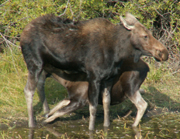
———————————–
In 2010, vehicles in the park hit and killed two wolves, five bears, 6 pronghorn, 17 bison, five moose, 41 deer and 48 elk. Most of the deaths occurred between dawn and dusk on the main highway between Moose and Moran Junctions.
Please drive the speed limit and be prepared to stop suddenly.
Speed was the biggest factor, especially at night when
people “overdrive their high beams – when stopping distance is greater than the headlight illumination distance.”
Driving slower than the posted speed limit, especially after dark, can save animal (and human) lives.
(Note to on-line users not in my classes: this is a study sheet. It is not complete instruction in the topic named in the webpage title.)
The author of this webpage, (written as a homework reading assignment for my students), does not give any warranty, expressed or implied, nor assume any legal liability or responsibility for the accuracy, completeness, or usefulness of any information, product, or process included in this website or at websites linked to or from it. Users of information from this website assume all liability arising from such use.
